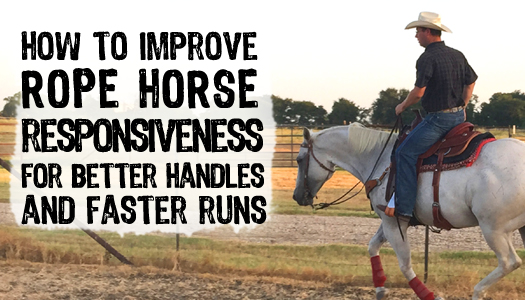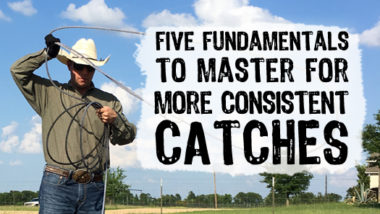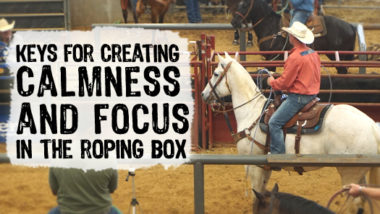Listen to this article in audio form! It’s #6 in the Team Roping Tips Podcast.
For the latest episodes subscribe on iTunes or your favorite podcast app.
We can’t miss what we’ve never experienced. This especially applies when it comes to well trained horses. Team roping is becoming more competitive all the time. Our roping fundamentals are important, but our real advantage is in our horsepower and our ability to control it.
Every run is dynamic, meaning that things are in motion and always changing. This is why it’s critical to have a horse that is in sync with us physically and mentally. We need to be able to make adjustments instantly in a run that give us the best shot, best handle, and best stop possible.
It’s common to find a horse that is either physically light or mentally solid, but a truly well broke horse has both of these qualities combined. These horses can separate good ropers from great and are worth their weight in gold.
The good news is, these horses are not just something we find but something we can create. Quality training and development can’t be understated. While natural equine talent can take us a long way, today’s team roping requires us to up our game and do everything possible to bring out the absolute best in our equine partners.
This means educating our horses in a way that creates clear communication, undoubtable understanding, hair trigger responsiveness and rock-solid confidence.
When I talk about lightness, I am referring to a horse’s physical response to pressure. This could be from the halter, bridle, legs or body language.
Softness on the other hand is more of a mental/emotional quality. An example of being soft would be calmness in the box, or being able to walk back up the arena at a relaxed walk. You can tell a lot about whether a horse is ‘soft’ by the expression in their eyes.
A light horse is not necessarily soft, but a soft horse is more likely to be light. This is because ‘softness’ encompasses a mental state that is conducive to learning. A soft horse has a calm willingness that a skeptical, bracey, tense or resistant horse lacks.
When our horse is soft, they don’t carry excess tension in their body because they are more balanced in their emotions. They will feel more loose and supple, because mental softness lends to physical softness. Chronic tension alone can cripple horses over time. When we develop our horse’s lightness and softness, we’re ensuring we can utilize them to their highest ability as well as increase their longevity.
When a horse is light in the bridle and has positive responses, we’re able to control any part of their body at any time. Team roping requires very specific positioning in a short amount of time, and by having direct communication with our horse that requires only the minimum amount of dialog, we can be more efficient, and therefore fast.
The same thing goes for responsiveness to our leg cues. We need to be effective in getting a response, but we want positive response – which is built by developing our horse’s understanding and consistency over time. This is a big benefit especially in the box. We may need to move our horse’s feet to get them breaking out of the box at a specific point, or to make sure they are standing up square. If we can’t very specifically and instantly place them, we’re playing a losing game before we start.
When you know how to prepare your horse to give you every advantage, you’ll no longer accept ‘just getting by.’
Below I’ve shared action steps for creating lightness in the bridle:
- No matter your horse’s age, lightness in the bridle starts with lightness in the halter. Don’t hesitate and go back and confirm your horse’s understanding and refine their responsiveness in a halter at any stage of their development.
- Set the intention before you begin to use as light of pressure as possible. Start by standing facing your horse’s shoulder and asking for lateral flexion (to the side) with the lead rope. You want the plane of their nose to stay vertical (without the nose tipping up or out). In the teaching stage you want to “set it up and wait” for our horse to give.
- Once they yield to the pressure, release it immediately to reward them. Reward the slightest try early on when teaching to reinforce the concept. As they improve, have higher expectations for their efforts, such as softening quicker, flexing further, and staying in the yield longer.
- Repeat this process until they can do this utilizing their full range of motion being as light as possible in their lateral flexion, and are able to softly hold the position on both sides of their body.
- Only when we’re confident our horse understands what we’re asking, would we want to utilize higher degrees of pressure to reinforce what we ask. If we force a horse to give to our hands in the beginning by making it extremely uncomfortable or impossible not to give, we actually forfeit their thinking process and learning (they are just trying to stay out of trouble). We want to give them a chance for their mental wheels to turn, which takes some time and patience.
- At any point you feel like you’ve been waiting too long and your horse isn’t motivated to respond or search for an answer, consider yielding their body or moving their feet to interrupt the pattern and change the subject, then start again. At the same time, you don’t want your horse to be “too wrong for too long” and learn to lean on pressure.
- Next, we need to teach vertical flexion in a halter as well, and all the same concepts apply. In this case, apply light downward pressure on the lead rope. When your horse understands this, you can put feel on the lead rope toward their chest that asks them to yield their chin back as well.
- If the horse starts backing up, make sure to keep your energy low to help them understand they are to keep their feet still. It’s our energy and intention that asks a horse to move their feet. They shouldn’t assume that they should run away from any type of pressure. Position them with a wall behind them if necessary and remember to reward the slightest try.
- Take these steps with your horse in a bridle to confirm the same understandings to bit pressure, first at a standstill then over time at all gaits. The more responsive a horse is to a halter and snaffle, the better they will respond to head gear made for more refined and advanced communication. The lighter and quicker our horse responds, the fewer delays we’ll experience in a run.
When you can do more with less, you can do more. – Heather Smith
Below I’ve shared action steps for creating lightness to leg cues:
- Properly prepare your horse by teaching them to yield sideways on the ground first using gradually increasing steady or rhythmic pressure with your hand, a stick & string, lead rope, etc. Ask them to yield their front end and hind quarters as well. Doing so will make these movements much easier under saddle.
- Always start out with very light pressure. Your horse will never respond lighter than the degree of the pressure you first apply. As you refine responsiveness, the concepts described below apply whether teaching your horse to yield to pressure from the ground or on their back.
- Be patient when first teaching a horse to respond to leg pressure, they’ll likely try several guesses at the correct answer before getting it right. Being too particular in the beginning will only discourage your horse – reward the slightest try.
- Consider positioning your horse in front of a wall or fence, where moving forward is not an option.
- Gradually increase the pressure you apply until you get the correct response. Instead of kicking harder, start by gradually bring up rhythmic life in your body and leg – think “fanning” instead of kicking.
- If your horse is not responding at all, STOP what you are doing and think of another way to get some kind of result (a light tap with a rein for example). If you keep asking in the same way, with no response (kick, kick, kick, etc.), you are actually teaching your horse to be dull and insensitive. When you start over, remember, to always start with very light pressure.
- Be sure when you get the slightest positive response in the teaching phase to RELEASE instantly. This is a critical part of gaining responsiveness to leg cues AND a critical part of horsemanship in general. The release is the reward your horse seeks out, it’s you saying “YES, that’s right!” The quicker you deliver the reward (release), the quicker your horse will learn.
- Start by asking your horse to respond to leg cues at a standstill. When that is well established, move up to a walk, and then trot, lope and so on. Experiment with yielding other body parts around (hips, shoulders) while traveling on a straight line or circle.
- If your horse already has a good understanding of leg cues, and is slow to respond, increase the rate (speed) at which you increase pressure. With advanced horses especially, don’t be afraid to raise the degree of firmness to get results. Most riders are initially too firm and then aren’t firm enough when necessary.
- When it’s time to advance – let’s say your horse responds OK to leg cues, but you want a quicker, snappier responsiveness – at this point, apply a light degree of pressure, and increase it until you get the responsiveness you desire, THEN GO BACK to the lighter amount of pressure you started with, instead of a complete release. When you’re beyond the teaching phase this offers more refinement and communicates that you “want this level of response from this level of pressure.”
“Once you have seen quality horsemanship and are exposed to the things you can do to help a horse be gentle and dependable, why wouldn’t you do those things? No matter what age your horses are, you are going to try to offer him the best that you can. If you adjust what you are doing, he will adjust too; horses have an amazing capacity to make changes.” – Buck Brannaman
Without a good foundation of understanding, there will be delays in the communication from us to our horse, which will slow us down and compromise our shot.
Once you’ve experienced a truly well broke, light and responsive horse, it’s not even appealing to rope on one that doesn’t have these man-made qualities.
Why wouldn’t we want to give ourselves every advantage? With the action steps above, now you have some tools to do so.
If you’d like more support beyond what I shared today, click here to learn about video coaching and be sure you’re subscribed to receive new roping tips when they’re published here at CraigSmithTeamRoping.com.


